There is something mystical about viewing a brilliant work of art. Perhaps it’s the fact that a few different combinations of paint strokes, colors, and textures have the power to make you feel deep emotions.
Whether it be love, anger, sadness, or joy, those feelings come from the very depth of who you are. Another beautiful aspect of looking at art is that it doesn’t take much effort to simply enjoy. All you need to do is gaze at the masterpiece.
For as long as humans have been on earth, art has been an essential part of life. Some of the earliest pieces of art were images of bulls, bison, and horses painted on a cave wall almost 17 thousand years ago. Ever since then, art has continually evolved.
Some of the most brilliant works of art worth seeing in person range from the early Renaissance period to the modern 21st century.

Autumn Rhythm
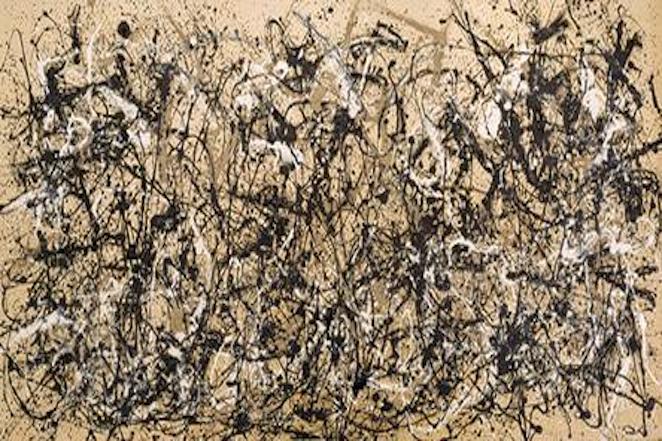 https://www.complex.com/style/2013/09/works-to-see-before-you-die/autumn-rhythm
https://www.complex.com/style/2013/09/works-to-see-before-you-die/autumn-rhythm There is a beauty to be found in the chaotic. In 1950, artist Jackson Pollock pushed the boundaries of traditional art when he created Autumn Rhythm. The masterpiece expresses a sense of high energy and power.
It was created by simply laying a canvas on the ground and dripping paint across the surface. This way of creating art is now called action painting.
Thousands of people travel to The Metropolitan Museum of Art in New York City to get a glimpse of one of the first pieces of action art.
The Kiss
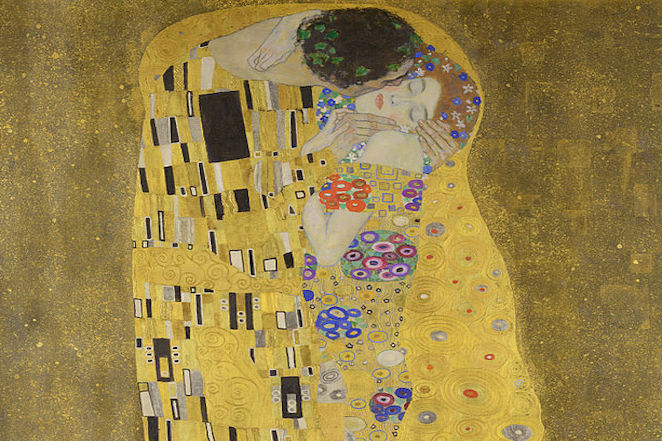 http://mentalfloss.com/article/53804/8-paintings-every-art-lover-must-see-person
http://mentalfloss.com/article/53804/8-paintings-every-art-lover-must-see-person Gustav Klimt painted The Kiss sometime between 1907 and 1908. As seen in many of his other paintings, Klimt used the highly decorated gold leaf and platinum. This special touch added a sense of richness and majesty to his creations.
The painting displays a tender passionate kiss between two lovers. The Kiss is currently housed in the Austrian Gallery Belvedere.
Slave Labour
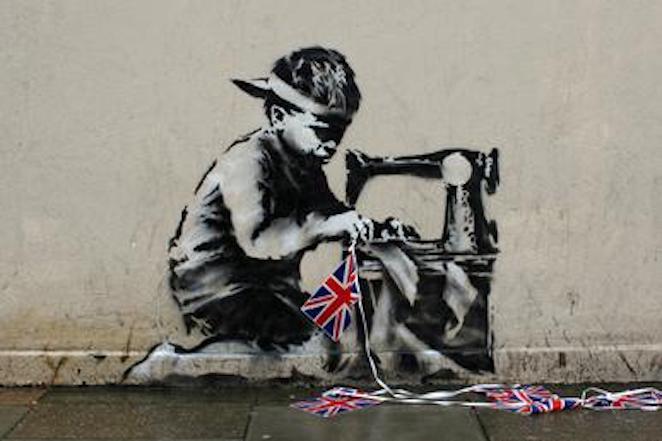 https://en.wikipedia.org/wiki/Slave_Labour_(mural)
https://en.wikipedia.org/wiki/Slave_Labour_(mural) Bansky, an anonymous street artist, creates his masterpieces during the darkness of the night. Slave Labour is one of those brilliant creations.
The mural is located on the sidewall of a Poundland store in Wood Green, London. It depicts a young boy sewing together small Union Jack flags. Banksy has been known to create art that revolves around political issues, war, and peace.
Venus De Milo
 https://www.ucityguides.com/cities/top-10-must-see-famous-works-of-art.html
https://www.ucityguides.com/cities/top-10-must-see-famous-works-of-art.html Art historians believe that the famous Venus De Milo sculpture was carved out of marble sometime during 150 B.C. by Alexandros of Antioch.
More than a thousand years later, the sculpture resurfaced on April 8, 1820. Pieces of the masterpiece were found on the Aegean island of Melos and presented to Louis XVIII. The artwork is now displayed at the Louvre in Paris, France.
View of Delft
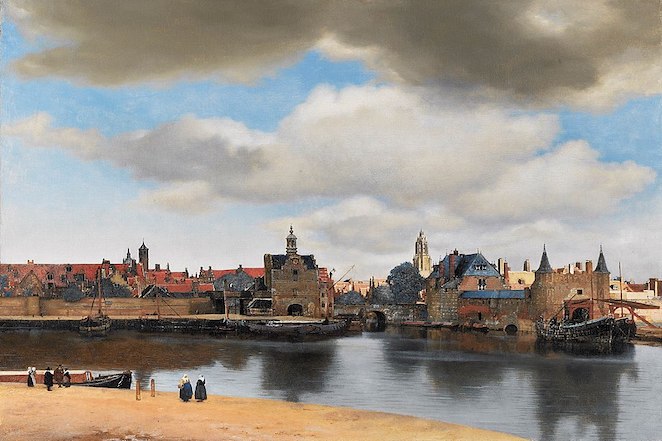 https://www.biographyonline.net/artists/great-works-art.html
https://www.biographyonline.net/artists/great-works-art.html Johannes Vermeer, a Dutch artist, broke boundaries when he painted View of Delft in 1661. At the time, it was very uncommon for artists to paint cityscapes. However, Vermeer felt that the beauty of his hometown needed to be portrayed on a canvas.
The painting is one of his most famous pieces. It is currently displayed in the Dutch Royal Cabinet of Paintings at the Mauritshuis in The Hague.
Inspiration of St Matthew
 https://www.biographyonline.net/artists/great-works-art.html
https://www.biographyonline.net/artists/great-works-art.html In 1602 Michelangelo Caravaggio was asked by the French Cardinal Matteo Contarellito to create a piece of artwork for the Contarelli Chapel. The Inspiration of St Matthew is one of the three masterpieces that made it into the chapel.
The stunning painting depicts a floating angel appearing to give Saint Matthew divine inspiration. Centuries later, the painting can still be seen in the church of the French congregation San Luigi de Francesi in Rome, Italy.
Water Lilies
 http://giverny.org/
http://giverny.org/ Oscar-Claude Monet, a French painter, is the founder of French Impressionist paintings. His soft, angelic depictions gracefully express his philosophy of nature. His Water Lilies series consists of approximately 250 oil paintings.
Monet’s inspiration for his masterpiece came from a pond near his home in Giverny, France. Pieces from his series can be found in museums all over the world
David
 https://www.biographyonline.net/artists/great-works-art.html
https://www.biographyonline.net/artists/great-works-art.html Michelangelo’s David sculpture is considered one of the most recognized works of the Renaissance period. The heroic male nude statue stands about 17 feet tall.
Art historians believe it was created to symbolize strength, youth, and beauty. The original sculpture is located in the Accademia Gallery of Florence, Italy. There is also a second copy located in Piazza Della Signoria.
The Lady With an Ermine
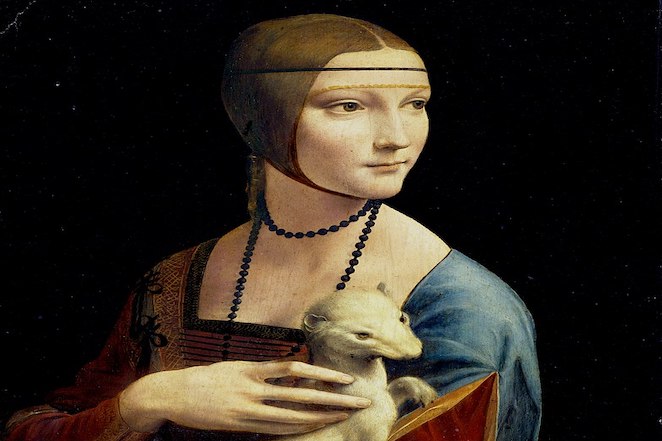 https://www.biographyonline.net/artists/great-works-art.html
https://www.biographyonline.net/artists/great-works-art.html Leonardo da Vinci perfectly depicts Ludovico Sforza’s favorite mistresses. When the Italian prince’s wife found out about his relationship with Cecilia Gallerani, she banished her from the Porta Giovia castle immediately.
One of the reasons that she is seen holding an ermine in the painting is because it symbolizes purity. The famous Renaissance painting can be found in the Main Building of the National Museum in Krakow, Poland.
Pietà
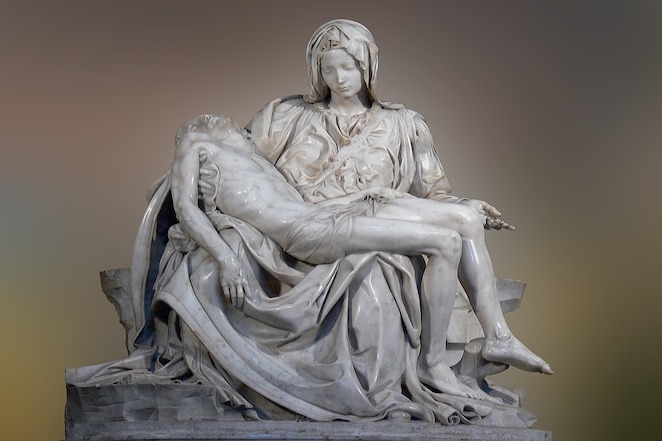 https://www.biographyonline.net/artists/great-works-art.html
https://www.biographyonline.net/artists/great-works-art.html Michelangelo Buonarroti created the Pietà, which was the first sculpture of his series specially made for the French Cardinal Jean de Bilhères.
The beautiful Renaissance sculpture depicts Mother Mary sorrowfully holding her son Jesus’ dead body in her lap. The masterpiece can be found at St. Peter’s Basilica located in Vatican City.
Liberty Leading the People
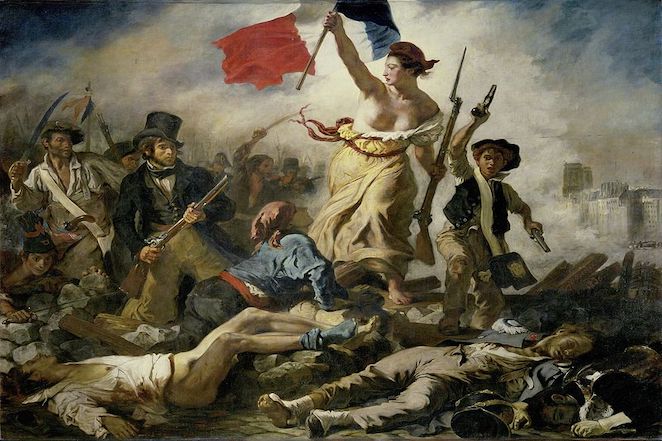 https://www.dailyartmagazine.com/liberty-leading-the-people/
https://www.dailyartmagazine.com/liberty-leading-the-people/ The Louvre Museum currently houses Eugène Delacroix’s Liberty Leading the People. Delacroix is considered one of the best French Romantic artists during his time.
When he created Liberty Leading the People in 1830, he wanted to create a powerful symbol of France. The picture displays a woman raising a French flag in the middle of a battlefield. Many people believe she is a symbol of freedom.
Paris Street; Rainy Day
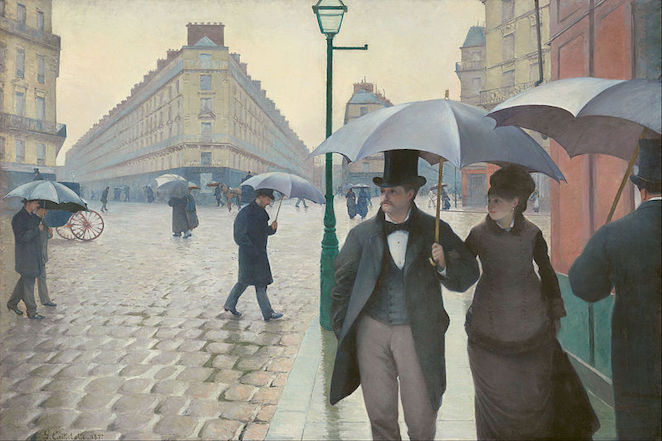 https://www.widewalls.ch/paris-street-rainy-day-gustave-caillebotte/
https://www.widewalls.ch/paris-street-rainy-day-gustave-caillebotte/ French artist Gustave Caillebotte does an amazing job portraying the effects of photography in his painting Paris Street; Rainy Day. He does this by slightly bulging in the center of the image to mirror how a camera would capture an image.
Caillebotte also gracefully depicts Paris as a modern city and the class differences between its residents. This photo-realistic painting can be found at the Art Institute of Chicago.
The Garden of Earthly Delights
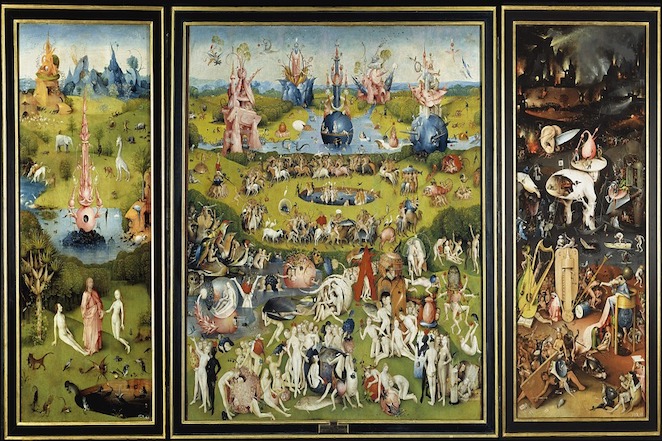 https://www.khanacademy.org/humanities/renaissance-reformation/northern/hieronymus-bosch/a/bosch-the-garden-of-earthly-delights
https://www.khanacademy.org/humanities/renaissance-reformation/northern/hieronymus-bosch/a/bosch-the-garden-of-earthly-delights There is an extreme amount of detail found within all three panels of The Garden of Earthly Delights. Each of the panels is interconnected and intended to be viewed from left to right.
Art critics believe the painting depicts a human’s experience from life to the afterlife. The masterpiece is currently being housed at the Museo del Prado in Madrid.
American Gothic
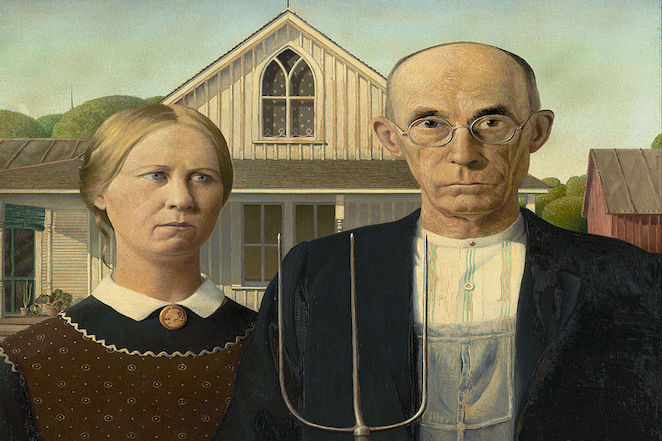 https://www.artic.edu/artworks/6565/american-gothic
https://www.artic.edu/artworks/6565/american-gothic Some art critics argue that Grant Wood’s paintings of the Midwest mock the people living in that region. Others believe he is accurately portraying the lives of the individuals who dedicated their time and very lives to the land.
American Gothic is perhaps one of Wood’s most famous pieces because it is considered a primary example of American Regionalism.
Outside the United States, the picture has been displayed at the Musée de l’Orangerie in Paris and at the Royal Academy of Arts in London.
A Sunday Afternoon on the Island of La Grande Jatte
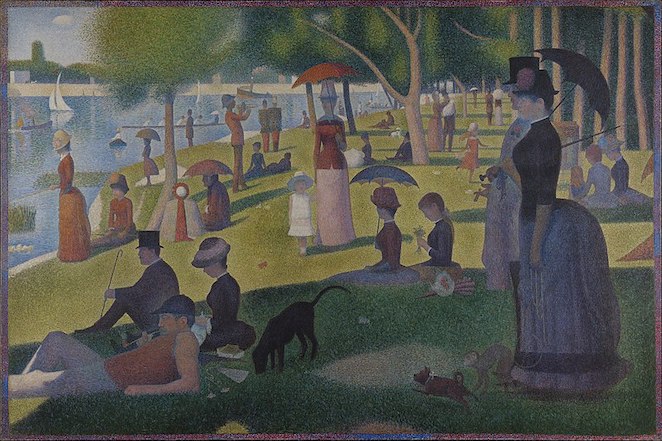 http://www.visual-arts-cork.com/paintings-analysis/sunday-afternoon-on-grande-jatte.htm
http://www.visual-arts-cork.com/paintings-analysis/sunday-afternoon-on-grande-jatte.htm George Seurat, a French painter, painted millions of dots to create A Sunday Afternoon on the Island of La Grande Jatte in 1884. The magnitude of those millions of tiny dots and rich colors come together to make a powerful optical effect for the viewer.
The 6’10” x 10’1” sized painting of fashion-savvy Parisians enjoying a lovely Sunday afternoon can be found at the Art Institute of Chicago.
The Persistence of Memory
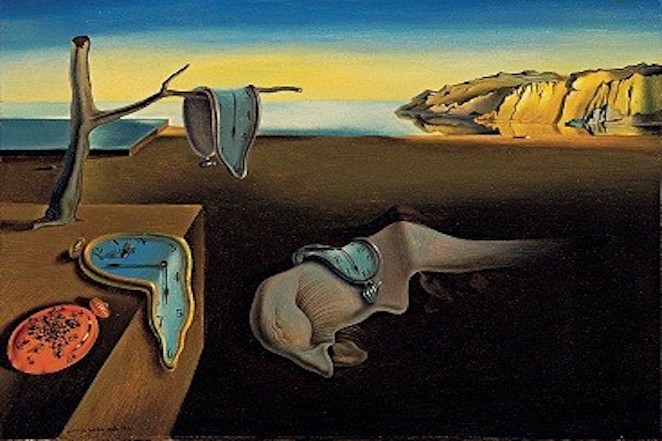 https://thedali.org/about-the-museum/timeline/
https://thedali.org/about-the-museum/timeline/ Salvador Domingo Felipe Jacinto Dali, a Spanish Surrealist painter, created The Persistence of Memory in 1931. A year later it could be seen at the Julien Levy Gallery and has been viewed more than a million times since then.
The picture’s strange subject matter is portrayed in a dream-like manner. The melting clocks symbolize the passage of time.
The famous painting is currently displayed at The Museum of Modern Art in New York City.
The Night Watch
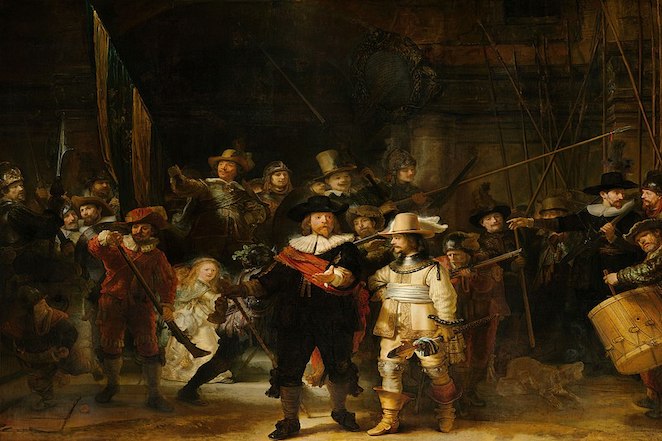 http://www.rembrandtpainting.net/rembrandt's_night_watch.htm
http://www.rembrandtpainting.net/rembrandt's_night_watch.htm Rembrandt van Rijn created The Night Watch, using oil paint on canvas in 1642. The art piece is rather large, measuring 11’ 11” x 14’ 4”. It depicts a group of militiamen being led by Frans Banninck Cocq.
Rijin used dark neutral colors with pops of aqua-green and deep reds to bring his painting to life. The famous Dutch Golden Age painting can be found at the Rijksmuseum in Amsterdam.
The Birth of Venus
 https://www.artsy.net/article/artsy-editorial-botticellis-birth-venus-pop-culture
https://www.artsy.net/article/artsy-editorial-botticellis-birth-venus-pop-culture Art Historians believe that Sandro Botticelli, an Italian artist, painted The Birth of Venus sometime during the 1480s. The painting displays the goddess Venus arriving to shore after her birth, fully grown.
Botticelli’s masterpiece is considered a landmark of 15th-century Italian artwork. Every year, thousands of visitors travel to Florence, Italy, to see the prized piece for themselves at the Uffizi Gallery.
Guernica
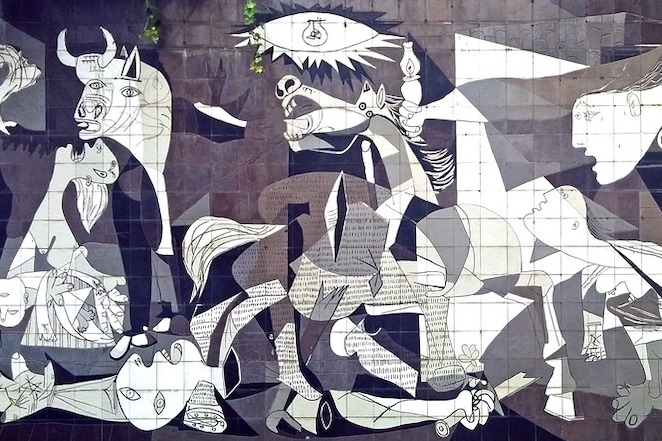 https://www.pablopicasso.org/guernica.jsp
https://www.pablopicasso.org/guernica.jsp People can be seen standing in awe as they gaze at Picasso’s Guernica painting. The vast canvas made up of just blue, black, and white almost covers a full wall at the Museo Reina Sofia in Madrid.
The masterpiece is considered one of the most moving anti-war paintings in the world. Picasso began painting the piece on April 26, 1937, and is believed to have finished just three months later.
Mona Lisa
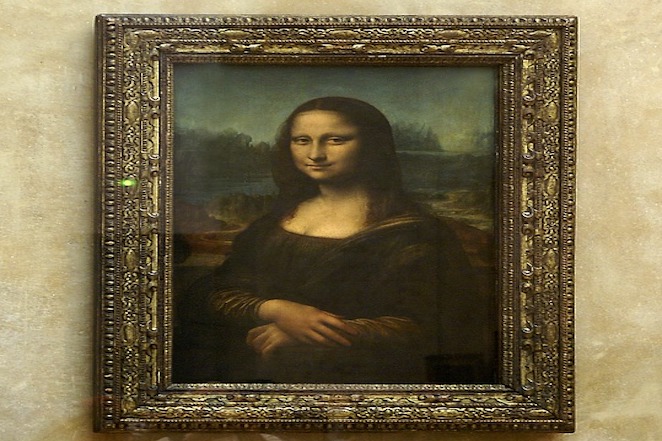 https://www.leonardodavinci.net/the-mona-lisa.jsp
https://www.leonardodavinci.net/the-mona-lisa.jsp The Mona Lisa was painted by Leonardo da Vinci in 1503. It is considered one of the most famous works of art in the world. One of the reasons is because Mona Lisa’s smile is an optical illusion. Her smile changes depending on where you focus your attention on the painting.
There is also a lot of mystery that surrounds this painting. You can see The Mona Lisa for yourself at the Louvre Museum in Paris, France.
Girl with a Pearl Earring
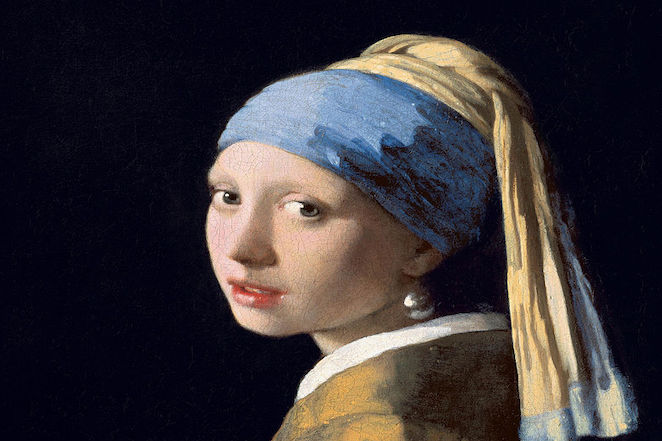 https://www.britannica.com/topic/Girl-with-a-Pearl-Earring-by-Vermeer
https://www.britannica.com/topic/Girl-with-a-Pearl-Earring-by-Vermeer The Girl with a Pearl Earring was painted by Johannes Vermeer in 1665. The painting itself is rather small, measuring 1’6” x 1’3”. Yet, it has made an immense impact on anyone who has had a chance to view it. Books and movies have been made, speculating her true story.
No one knows who the girl in the painting really is or if she ever existed. The masterpiece currently resides in the Mauritshuis museum in The Hague.
The Scream
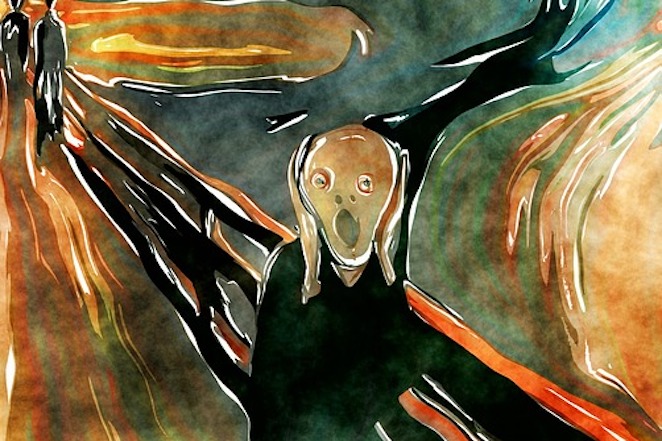 https://legomenon.com/meaning-of-the-scream-1893-painting-by-edvard-munch.html
https://legomenon.com/meaning-of-the-scream-1893-painting-by-edvard-munch.html Der Schrei De Natur, more commonly known as The Scream, is a famous oil painting created by Edvard Munch in 1893. The picture of a man holding his face while he screams is considered to be an icon of modern art, partly for its universal meaning.
It’s widely believed that The Scream is a reference to Munch’s soul and his inner troubles. The masterpiece is currently displayed in the Munch Museum in Oslo.
The Starry Night
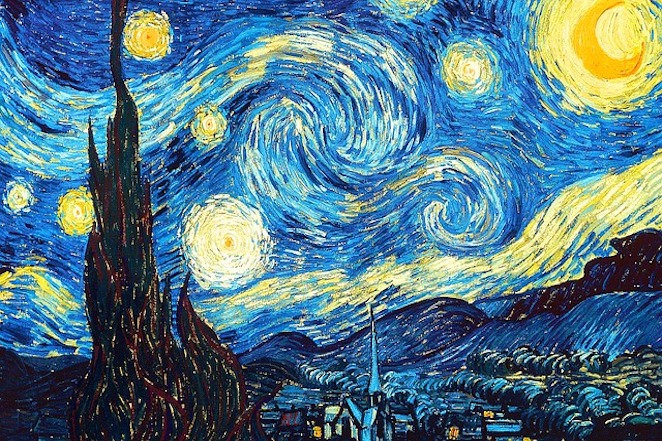 https://www.moma.org/learn/moma_learning/vincent-van-gogh-the-starry-night-1889/
https://www.moma.org/learn/moma_learning/vincent-van-gogh-the-starry-night-1889/ Vincent van Gogh, a Dutch post-impressionist painter, is known for his influential masterpieces. Over his lifetime, he created around 2,100 works of art.
The Starry Night, painted in June 1889, is one of his most renowned. The piece depicts the east-facing view from his asylum room at the Saint-Rémy-de-Provence just around sunrise.
The painting is currently located at the Museum of Modern Art in New York City.
The Last Supper
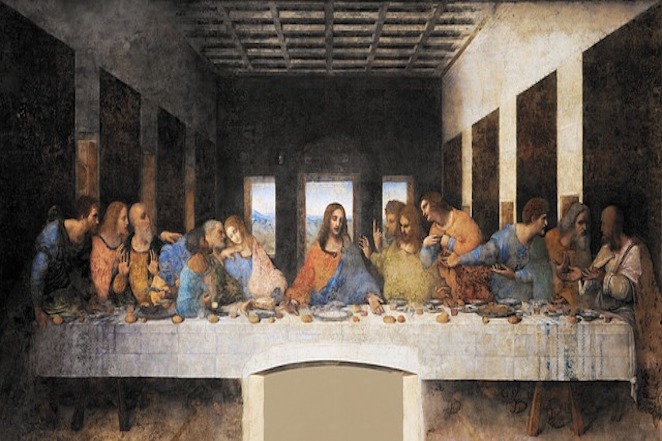 https://www.leonardodavinci.net/the-last-supper.jsp
https://www.leonardodavinci.net/the-last-supper.jsp Mystery and beauty surround Leonardo da Vinci’s depiction of The Last Supper. The piece of art has been widely examined in the hopes of finding even more hidden details.
In 2007, Giovanni Maria Pala, an Italian musician, created a 40-second melody from the notes that are allegedly hidden in the scene. The 15th-century mural painting currently resides at the Convent of Santa Maria Delle Grazie in Milan, Italy.
Sistine Chapel Ceiling
 https://www.leonardodavinci.net/the-last-supper.jsp
https://www.leonardodavinci.net/the-last-supper.jsp Historians believe that the artist Michelangelo painted The Sistine Chapel ceiling sometime between 1508 and 1512. The breathtaking Renaissance masterpiece is about 131 feet long and 43 feet wide.
A few depicted scenes that were painted include “The Separation of Light From Darkness” and “The Drunkenness of Noah.” It is thought to have taken Michelangelo around four years to complete.
An estimated five million people travel to Vatican City every year to see the piece of art located within the Apostolic Palace.



























